Roles and Responsibilities of Marketing Function
VerifiedAdded on 2023/02/02
|14
|5406
|85
AI Summary
This document explains the key roles and responsibilities of the marketing function in an organization. It discusses the marketing process and how it relates to the wider organizational context. It also compares the ways in which different organizations apply the marketing mix to achieve their business objectives. The document provides insights into the nature and scope of marketing, as well as the importance of understanding consumer needs and wants. It also highlights the impact of the external environment on marketing activities.
Contribute Materials
Your contribution can guide someone’s learning journey. Share your
documents today.

UNIT 2
MARKETING ESSENTIAL
Introduction
Some use the term "marketing" as a fashionable word for "sale." Of course, selling is part of
the marketing process, but marketing is much more than that. Others use this term for all
types of promotion and advertising. Again, they are part of marketing, but they are not
everything.
In fact, marketing is a lot more extensive than promotion, advertising and selling. In the most
complete sense, marketing is a general term that includes the position of an enterprise among
market competitors, its competitive advantage and the selection of viable market segments on
which it will focus.
If certain market segments have been selected (and these have been chosen in a positive way
to avoid others), marketing also includes communication with customers in selected markets.
This communication is a dialogue, not a monologue. In other words, marketing includes
listening to customers - or market research.
Only then will we proceed to the formulation of precise messages tailored to the needs of
different types of customers. Each of these messages is then transmitted using the most
appropriate environment in that situation.
These concrete marketing messages are created and transmitted according to a technique
called the "Three Marketing M".
So we have to understand that marketing is much more than promotion and sales. It's a way
to analyze the entire activity in relation to the markets. By using the full range of marketing
tools, we can successfully succeed by effectively avoiding competitors and serving with
clientele.
In order for our business to be successful, we need to use all aspects of marketing: strategic
marketing, competitors' analysis, market positioning, market research, and finally marketing
messages.
Chosen Company Background
Aldi is the abbreviation for "ALbrecht DIscount", a German cash and carry retail company,
originally founded in 1913 and named after current owners, the brothers Karl and Theo
Albrecht. In 1960, the company broke up in two: "Aldi Nord" (Theo) and "Aldi Sud" (Karl).
MARKETING ESSENTIAL
Introduction
Some use the term "marketing" as a fashionable word for "sale." Of course, selling is part of
the marketing process, but marketing is much more than that. Others use this term for all
types of promotion and advertising. Again, they are part of marketing, but they are not
everything.
In fact, marketing is a lot more extensive than promotion, advertising and selling. In the most
complete sense, marketing is a general term that includes the position of an enterprise among
market competitors, its competitive advantage and the selection of viable market segments on
which it will focus.
If certain market segments have been selected (and these have been chosen in a positive way
to avoid others), marketing also includes communication with customers in selected markets.
This communication is a dialogue, not a monologue. In other words, marketing includes
listening to customers - or market research.
Only then will we proceed to the formulation of precise messages tailored to the needs of
different types of customers. Each of these messages is then transmitted using the most
appropriate environment in that situation.
These concrete marketing messages are created and transmitted according to a technique
called the "Three Marketing M".
So we have to understand that marketing is much more than promotion and sales. It's a way
to analyze the entire activity in relation to the markets. By using the full range of marketing
tools, we can successfully succeed by effectively avoiding competitors and serving with
clientele.
In order for our business to be successful, we need to use all aspects of marketing: strategic
marketing, competitors' analysis, market positioning, market research, and finally marketing
messages.
Chosen Company Background
Aldi is the abbreviation for "ALbrecht DIscount", a German cash and carry retail company,
originally founded in 1913 and named after current owners, the brothers Karl and Theo
Albrecht. In 1960, the company broke up in two: "Aldi Nord" (Theo) and "Aldi Sud" (Karl).
Secure Best Marks with AI Grader
Need help grading? Try our AI Grader for instant feedback on your assignments.
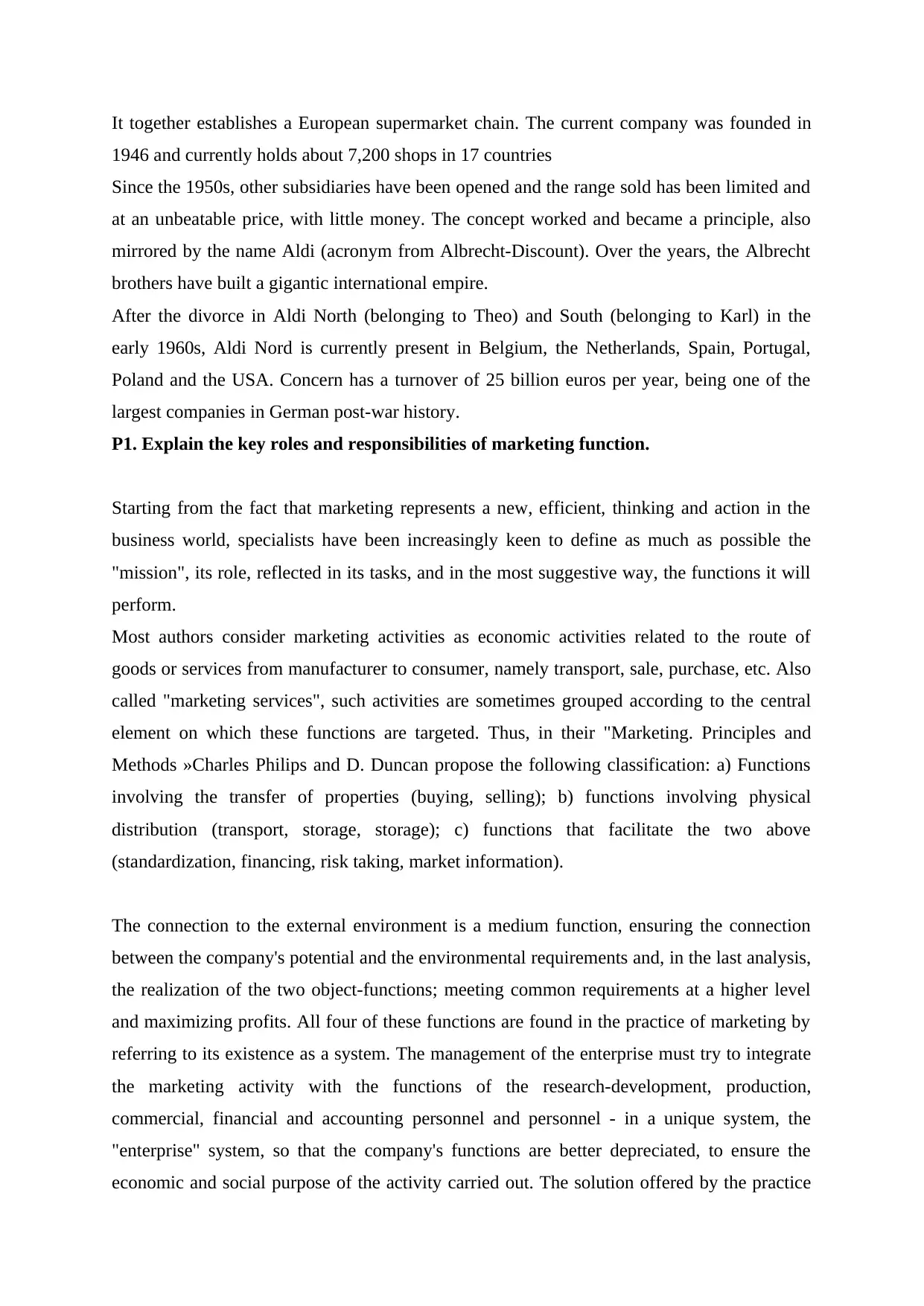
It together establishes a European supermarket chain. The current company was founded in
1946 and currently holds about 7,200 shops in 17 countries
Since the 1950s, other subsidiaries have been opened and the range sold has been limited and
at an unbeatable price, with little money. The concept worked and became a principle, also
mirrored by the name Aldi (acronym from Albrecht-Discount). Over the years, the Albrecht
brothers have built a gigantic international empire.
After the divorce in Aldi North (belonging to Theo) and South (belonging to Karl) in the
early 1960s, Aldi Nord is currently present in Belgium, the Netherlands, Spain, Portugal,
Poland and the USA. Concern has a turnover of 25 billion euros per year, being one of the
largest companies in German post-war history.
P1. Explain the key roles and responsibilities of marketing function.
Starting from the fact that marketing represents a new, efficient, thinking and action in the
business world, specialists have been increasingly keen to define as much as possible the
"mission", its role, reflected in its tasks, and in the most suggestive way, the functions it will
perform.
Most authors consider marketing activities as economic activities related to the route of
goods or services from manufacturer to consumer, namely transport, sale, purchase, etc. Also
called "marketing services", such activities are sometimes grouped according to the central
element on which these functions are targeted. Thus, in their "Marketing. Principles and
Methods »Charles Philips and D. Duncan propose the following classification: a) Functions
involving the transfer of properties (buying, selling); b) functions involving physical
distribution (transport, storage, storage); c) functions that facilitate the two above
(standardization, financing, risk taking, market information).
The connection to the external environment is a medium function, ensuring the connection
between the company's potential and the environmental requirements and, in the last analysis,
the realization of the two object-functions; meeting common requirements at a higher level
and maximizing profits. All four of these functions are found in the practice of marketing by
referring to its existence as a system. The management of the enterprise must try to integrate
the marketing activity with the functions of the research-development, production,
commercial, financial and accounting personnel and personnel - in a unique system, the
"enterprise" system, so that the company's functions are better depreciated, to ensure the
economic and social purpose of the activity carried out. The solution offered by the practice
1946 and currently holds about 7,200 shops in 17 countries
Since the 1950s, other subsidiaries have been opened and the range sold has been limited and
at an unbeatable price, with little money. The concept worked and became a principle, also
mirrored by the name Aldi (acronym from Albrecht-Discount). Over the years, the Albrecht
brothers have built a gigantic international empire.
After the divorce in Aldi North (belonging to Theo) and South (belonging to Karl) in the
early 1960s, Aldi Nord is currently present in Belgium, the Netherlands, Spain, Portugal,
Poland and the USA. Concern has a turnover of 25 billion euros per year, being one of the
largest companies in German post-war history.
P1. Explain the key roles and responsibilities of marketing function.
Starting from the fact that marketing represents a new, efficient, thinking and action in the
business world, specialists have been increasingly keen to define as much as possible the
"mission", its role, reflected in its tasks, and in the most suggestive way, the functions it will
perform.
Most authors consider marketing activities as economic activities related to the route of
goods or services from manufacturer to consumer, namely transport, sale, purchase, etc. Also
called "marketing services", such activities are sometimes grouped according to the central
element on which these functions are targeted. Thus, in their "Marketing. Principles and
Methods »Charles Philips and D. Duncan propose the following classification: a) Functions
involving the transfer of properties (buying, selling); b) functions involving physical
distribution (transport, storage, storage); c) functions that facilitate the two above
(standardization, financing, risk taking, market information).
The connection to the external environment is a medium function, ensuring the connection
between the company's potential and the environmental requirements and, in the last analysis,
the realization of the two object-functions; meeting common requirements at a higher level
and maximizing profits. All four of these functions are found in the practice of marketing by
referring to its existence as a system. The management of the enterprise must try to integrate
the marketing activity with the functions of the research-development, production,
commercial, financial and accounting personnel and personnel - in a unique system, the
"enterprise" system, so that the company's functions are better depreciated, to ensure the
economic and social purpose of the activity carried out. The solution offered by the practice
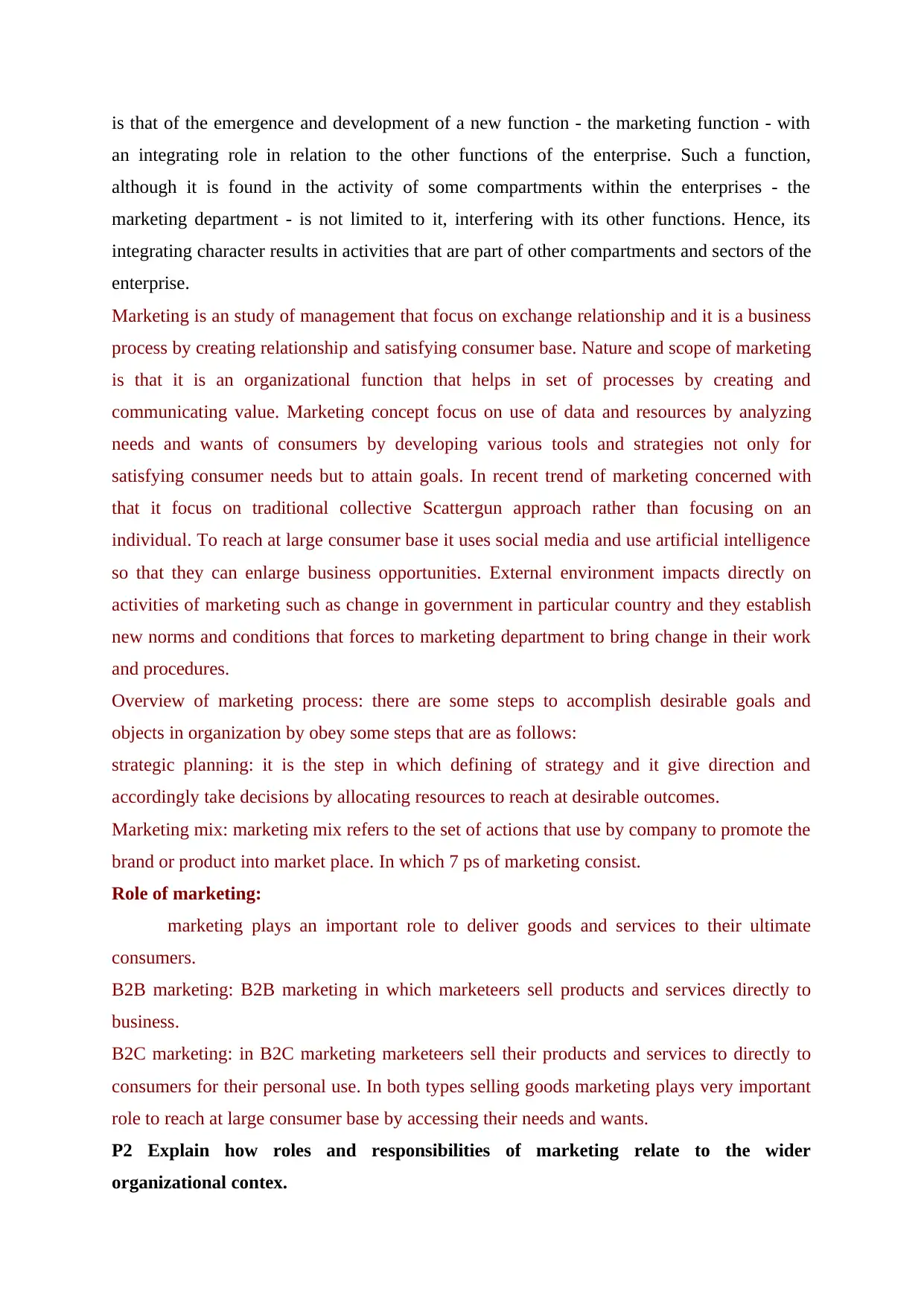
is that of the emergence and development of a new function - the marketing function - with
an integrating role in relation to the other functions of the enterprise. Such a function,
although it is found in the activity of some compartments within the enterprises - the
marketing department - is not limited to it, interfering with its other functions. Hence, its
integrating character results in activities that are part of other compartments and sectors of the
enterprise.
Marketing is an study of management that focus on exchange relationship and it is a business
process by creating relationship and satisfying consumer base. Nature and scope of marketing
is that it is an organizational function that helps in set of processes by creating and
communicating value. Marketing concept focus on use of data and resources by analyzing
needs and wants of consumers by developing various tools and strategies not only for
satisfying consumer needs but to attain goals. In recent trend of marketing concerned with
that it focus on traditional collective Scattergun approach rather than focusing on an
individual. To reach at large consumer base it uses social media and use artificial intelligence
so that they can enlarge business opportunities. External environment impacts directly on
activities of marketing such as change in government in particular country and they establish
new norms and conditions that forces to marketing department to bring change in their work
and procedures.
Overview of marketing process: there are some steps to accomplish desirable goals and
objects in organization by obey some steps that are as follows:
strategic planning: it is the step in which defining of strategy and it give direction and
accordingly take decisions by allocating resources to reach at desirable outcomes.
Marketing mix: marketing mix refers to the set of actions that use by company to promote the
brand or product into market place. In which 7 ps of marketing consist.
Role of marketing:
marketing plays an important role to deliver goods and services to their ultimate
consumers.
B2B marketing: B2B marketing in which marketeers sell products and services directly to
business.
B2C marketing: in B2C marketing marketeers sell their products and services to directly to
consumers for their personal use. In both types selling goods marketing plays very important
role to reach at large consumer base by accessing their needs and wants.
P2 Explain how roles and responsibilities of marketing relate to the wider
organizational contex.
an integrating role in relation to the other functions of the enterprise. Such a function,
although it is found in the activity of some compartments within the enterprises - the
marketing department - is not limited to it, interfering with its other functions. Hence, its
integrating character results in activities that are part of other compartments and sectors of the
enterprise.
Marketing is an study of management that focus on exchange relationship and it is a business
process by creating relationship and satisfying consumer base. Nature and scope of marketing
is that it is an organizational function that helps in set of processes by creating and
communicating value. Marketing concept focus on use of data and resources by analyzing
needs and wants of consumers by developing various tools and strategies not only for
satisfying consumer needs but to attain goals. In recent trend of marketing concerned with
that it focus on traditional collective Scattergun approach rather than focusing on an
individual. To reach at large consumer base it uses social media and use artificial intelligence
so that they can enlarge business opportunities. External environment impacts directly on
activities of marketing such as change in government in particular country and they establish
new norms and conditions that forces to marketing department to bring change in their work
and procedures.
Overview of marketing process: there are some steps to accomplish desirable goals and
objects in organization by obey some steps that are as follows:
strategic planning: it is the step in which defining of strategy and it give direction and
accordingly take decisions by allocating resources to reach at desirable outcomes.
Marketing mix: marketing mix refers to the set of actions that use by company to promote the
brand or product into market place. In which 7 ps of marketing consist.
Role of marketing:
marketing plays an important role to deliver goods and services to their ultimate
consumers.
B2B marketing: B2B marketing in which marketeers sell products and services directly to
business.
B2C marketing: in B2C marketing marketeers sell their products and services to directly to
consumers for their personal use. In both types selling goods marketing plays very important
role to reach at large consumer base by accessing their needs and wants.
P2 Explain how roles and responsibilities of marketing relate to the wider
organizational contex.
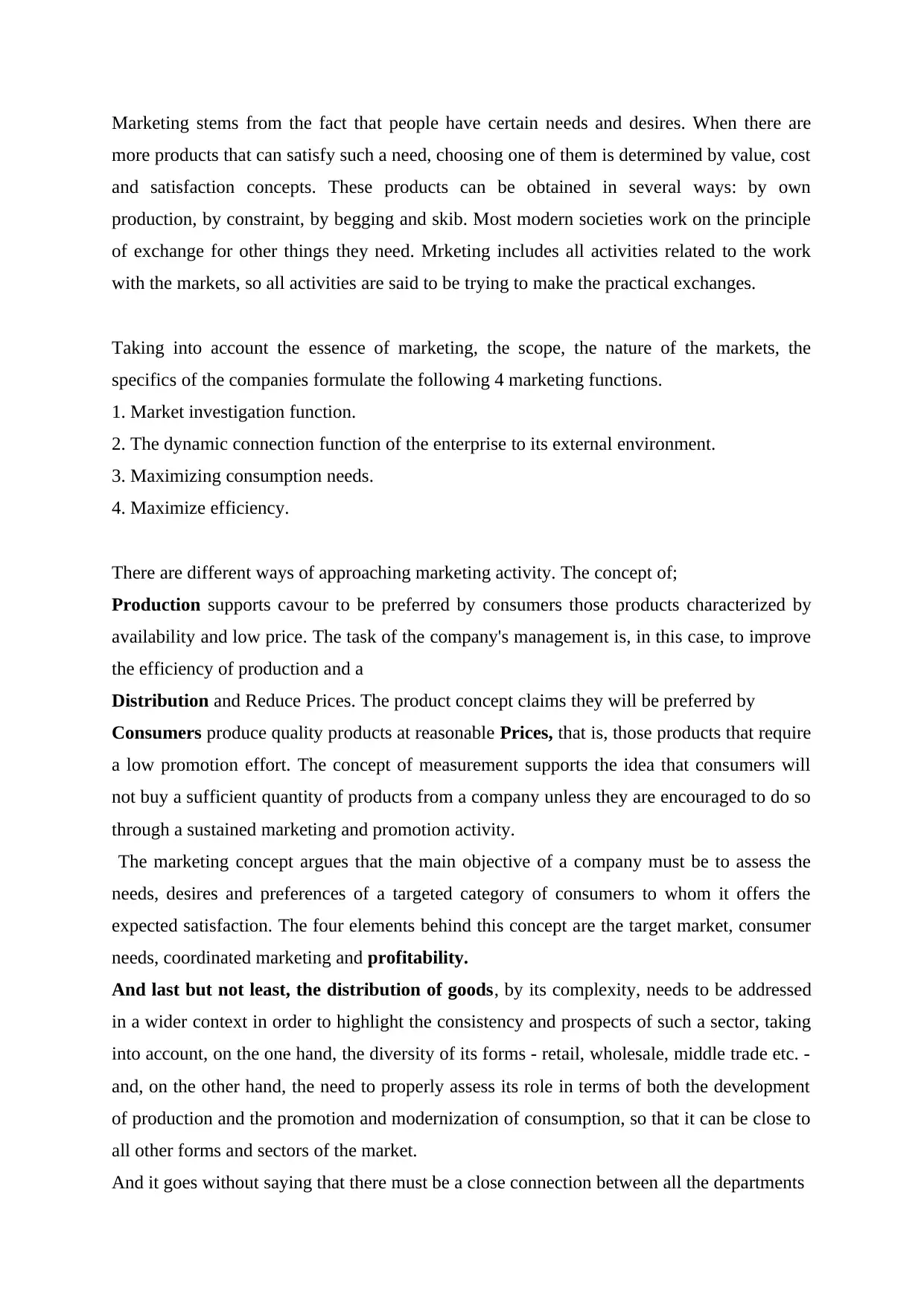
Marketing stems from the fact that people have certain needs and desires. When there are
more products that can satisfy such a need, choosing one of them is determined by value, cost
and satisfaction concepts. These products can be obtained in several ways: by own
production, by constraint, by begging and skib. Most modern societies work on the principle
of exchange for other things they need. Mrketing includes all activities related to the work
with the markets, so all activities are said to be trying to make the practical exchanges.
Taking into account the essence of marketing, the scope, the nature of the markets, the
specifics of the companies formulate the following 4 marketing functions.
1. Market investigation function.
2. The dynamic connection function of the enterprise to its external environment.
3. Maximizing consumption needs.
4. Maximize efficiency.
There are different ways of approaching marketing activity. The concept of;
Production supports cavour to be preferred by consumers those products characterized by
availability and low price. The task of the company's management is, in this case, to improve
the efficiency of production and a
Distribution and Reduce Prices. The product concept claims they will be preferred by
Consumers produce quality products at reasonable Prices, that is, those products that require
a low promotion effort. The concept of measurement supports the idea that consumers will
not buy a sufficient quantity of products from a company unless they are encouraged to do so
through a sustained marketing and promotion activity.
The marketing concept argues that the main objective of a company must be to assess the
needs, desires and preferences of a targeted category of consumers to whom it offers the
expected satisfaction. The four elements behind this concept are the target market, consumer
needs, coordinated marketing and profitability.
And last but not least, the distribution of goods, by its complexity, needs to be addressed
in a wider context in order to highlight the consistency and prospects of such a sector, taking
into account, on the one hand, the diversity of its forms - retail, wholesale, middle trade etc. -
and, on the other hand, the need to properly assess its role in terms of both the development
of production and the promotion and modernization of consumption, so that it can be close to
all other forms and sectors of the market.
And it goes without saying that there must be a close connection between all the departments
more products that can satisfy such a need, choosing one of them is determined by value, cost
and satisfaction concepts. These products can be obtained in several ways: by own
production, by constraint, by begging and skib. Most modern societies work on the principle
of exchange for other things they need. Mrketing includes all activities related to the work
with the markets, so all activities are said to be trying to make the practical exchanges.
Taking into account the essence of marketing, the scope, the nature of the markets, the
specifics of the companies formulate the following 4 marketing functions.
1. Market investigation function.
2. The dynamic connection function of the enterprise to its external environment.
3. Maximizing consumption needs.
4. Maximize efficiency.
There are different ways of approaching marketing activity. The concept of;
Production supports cavour to be preferred by consumers those products characterized by
availability and low price. The task of the company's management is, in this case, to improve
the efficiency of production and a
Distribution and Reduce Prices. The product concept claims they will be preferred by
Consumers produce quality products at reasonable Prices, that is, those products that require
a low promotion effort. The concept of measurement supports the idea that consumers will
not buy a sufficient quantity of products from a company unless they are encouraged to do so
through a sustained marketing and promotion activity.
The marketing concept argues that the main objective of a company must be to assess the
needs, desires and preferences of a targeted category of consumers to whom it offers the
expected satisfaction. The four elements behind this concept are the target market, consumer
needs, coordinated marketing and profitability.
And last but not least, the distribution of goods, by its complexity, needs to be addressed
in a wider context in order to highlight the consistency and prospects of such a sector, taking
into account, on the one hand, the diversity of its forms - retail, wholesale, middle trade etc. -
and, on the other hand, the need to properly assess its role in terms of both the development
of production and the promotion and modernization of consumption, so that it can be close to
all other forms and sectors of the market.
And it goes without saying that there must be a close connection between all the departments
Secure Best Marks with AI Grader
Need help grading? Try our AI Grader for instant feedback on your assignments.
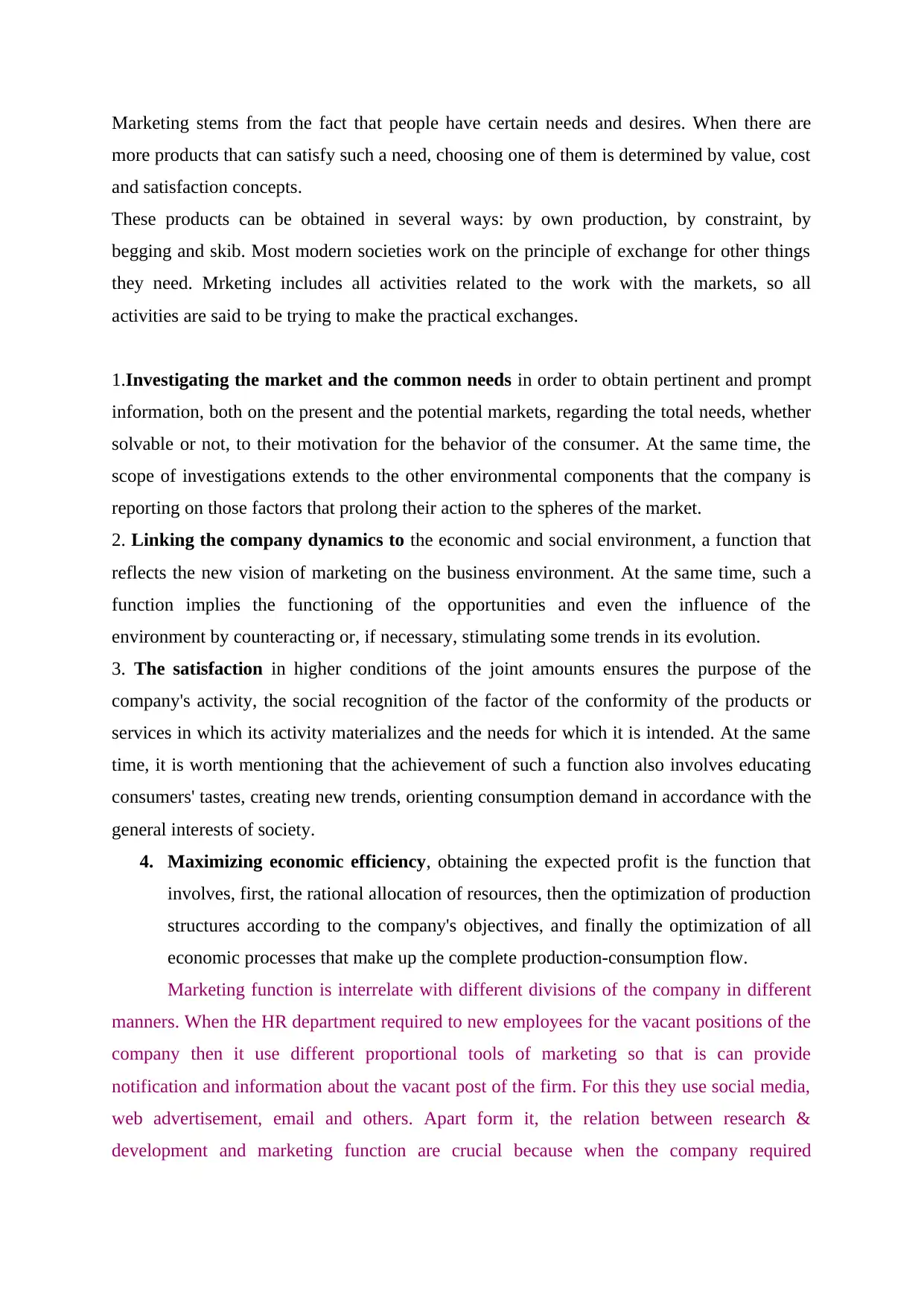
Marketing stems from the fact that people have certain needs and desires. When there are
more products that can satisfy such a need, choosing one of them is determined by value, cost
and satisfaction concepts.
These products can be obtained in several ways: by own production, by constraint, by
begging and skib. Most modern societies work on the principle of exchange for other things
they need. Mrketing includes all activities related to the work with the markets, so all
activities are said to be trying to make the practical exchanges.
1.Investigating the market and the common needs in order to obtain pertinent and prompt
information, both on the present and the potential markets, regarding the total needs, whether
solvable or not, to their motivation for the behavior of the consumer. At the same time, the
scope of investigations extends to the other environmental components that the company is
reporting on those factors that prolong their action to the spheres of the market.
2. Linking the company dynamics to the economic and social environment, a function that
reflects the new vision of marketing on the business environment. At the same time, such a
function implies the functioning of the opportunities and even the influence of the
environment by counteracting or, if necessary, stimulating some trends in its evolution.
3. The satisfaction in higher conditions of the joint amounts ensures the purpose of the
company's activity, the social recognition of the factor of the conformity of the products or
services in which its activity materializes and the needs for which it is intended. At the same
time, it is worth mentioning that the achievement of such a function also involves educating
consumers' tastes, creating new trends, orienting consumption demand in accordance with the
general interests of society.
4. Maximizing economic efficiency, obtaining the expected profit is the function that
involves, first, the rational allocation of resources, then the optimization of production
structures according to the company's objectives, and finally the optimization of all
economic processes that make up the complete production-consumption flow.
Marketing function is interrelate with different divisions of the company in different
manners. When the HR department required to new employees for the vacant positions of the
company then it use different proportional tools of marketing so that is can provide
notification and information about the vacant post of the firm. For this they use social media,
web advertisement, email and others. Apart form it, the relation between research &
development and marketing function are crucial because when the company required
more products that can satisfy such a need, choosing one of them is determined by value, cost
and satisfaction concepts.
These products can be obtained in several ways: by own production, by constraint, by
begging and skib. Most modern societies work on the principle of exchange for other things
they need. Mrketing includes all activities related to the work with the markets, so all
activities are said to be trying to make the practical exchanges.
1.Investigating the market and the common needs in order to obtain pertinent and prompt
information, both on the present and the potential markets, regarding the total needs, whether
solvable or not, to their motivation for the behavior of the consumer. At the same time, the
scope of investigations extends to the other environmental components that the company is
reporting on those factors that prolong their action to the spheres of the market.
2. Linking the company dynamics to the economic and social environment, a function that
reflects the new vision of marketing on the business environment. At the same time, such a
function implies the functioning of the opportunities and even the influence of the
environment by counteracting or, if necessary, stimulating some trends in its evolution.
3. The satisfaction in higher conditions of the joint amounts ensures the purpose of the
company's activity, the social recognition of the factor of the conformity of the products or
services in which its activity materializes and the needs for which it is intended. At the same
time, it is worth mentioning that the achievement of such a function also involves educating
consumers' tastes, creating new trends, orienting consumption demand in accordance with the
general interests of society.
4. Maximizing economic efficiency, obtaining the expected profit is the function that
involves, first, the rational allocation of resources, then the optimization of production
structures according to the company's objectives, and finally the optimization of all
economic processes that make up the complete production-consumption flow.
Marketing function is interrelate with different divisions of the company in different
manners. When the HR department required to new employees for the vacant positions of the
company then it use different proportional tools of marketing so that is can provide
notification and information about the vacant post of the firm. For this they use social media,
web advertisement, email and others. Apart form it, the relation between research &
development and marketing function are crucial because when the company required
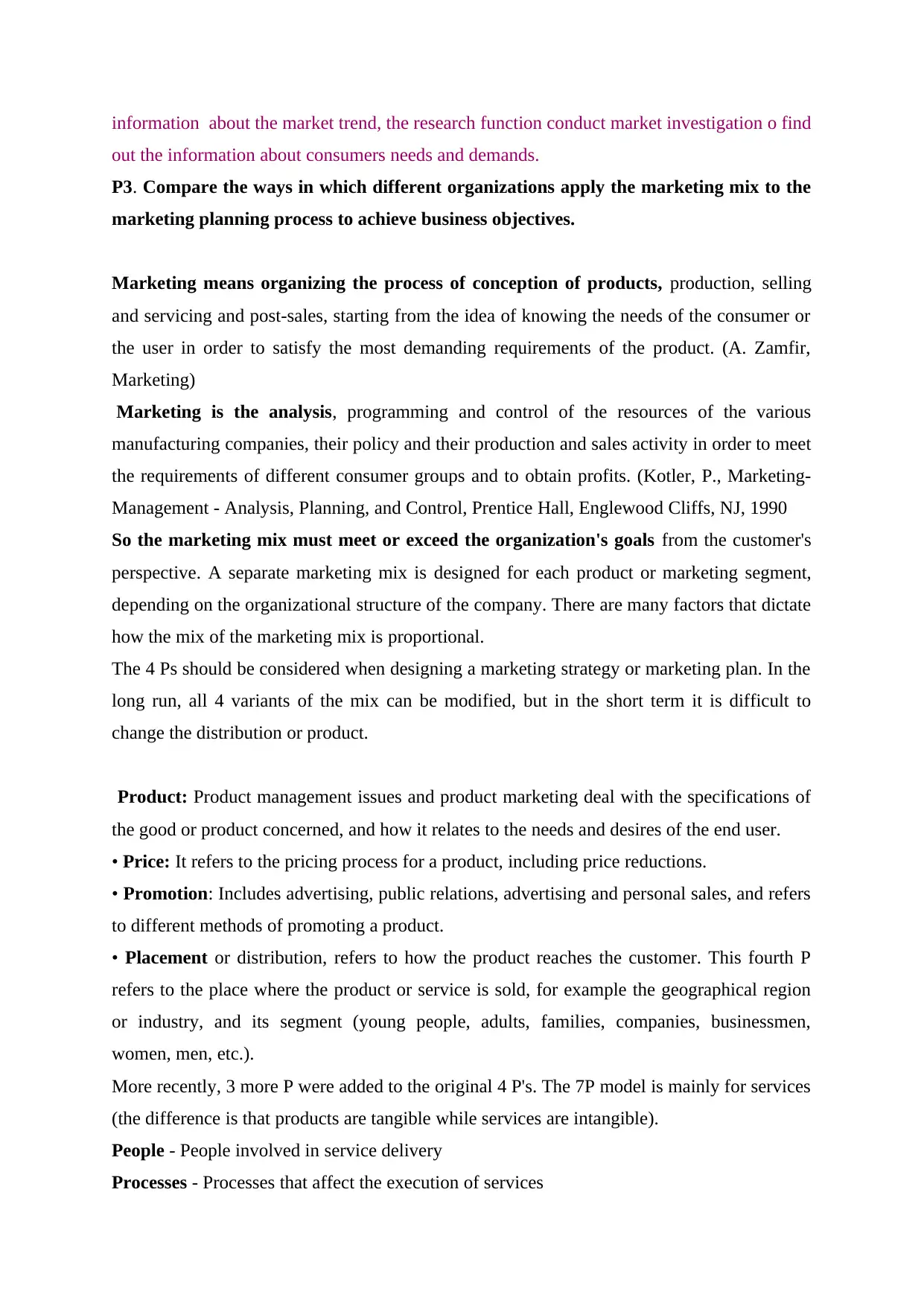
information about the market trend, the research function conduct market investigation o find
out the information about consumers needs and demands.
P3. Compare the ways in which different organizations apply the marketing mix to the
marketing planning process to achieve business objectives.
Marketing means organizing the process of conception of products, production, selling
and servicing and post-sales, starting from the idea of knowing the needs of the consumer or
the user in order to satisfy the most demanding requirements of the product. (A. Zamfir,
Marketing)
Marketing is the analysis, programming and control of the resources of the various
manufacturing companies, their policy and their production and sales activity in order to meet
the requirements of different consumer groups and to obtain profits. (Kotler, P., Marketing-
Management - Analysis, Planning, and Control, Prentice Hall, Englewood Cliffs, NJ, 1990
So the marketing mix must meet or exceed the organization's goals from the customer's
perspective. A separate marketing mix is designed for each product or marketing segment,
depending on the organizational structure of the company. There are many factors that dictate
how the mix of the marketing mix is proportional.
The 4 Ps should be considered when designing a marketing strategy or marketing plan. In the
long run, all 4 variants of the mix can be modified, but in the short term it is difficult to
change the distribution or product.
Product: Product management issues and product marketing deal with the specifications of
the good or product concerned, and how it relates to the needs and desires of the end user.
• Price: It refers to the pricing process for a product, including price reductions.
• Promotion: Includes advertising, public relations, advertising and personal sales, and refers
to different methods of promoting a product.
• Placement or distribution, refers to how the product reaches the customer. This fourth P
refers to the place where the product or service is sold, for example the geographical region
or industry, and its segment (young people, adults, families, companies, businessmen,
women, men, etc.).
More recently, 3 more P were added to the original 4 P's. The 7P model is mainly for services
(the difference is that products are tangible while services are intangible).
People - People involved in service delivery
Processes - Processes that affect the execution of services
out the information about consumers needs and demands.
P3. Compare the ways in which different organizations apply the marketing mix to the
marketing planning process to achieve business objectives.
Marketing means organizing the process of conception of products, production, selling
and servicing and post-sales, starting from the idea of knowing the needs of the consumer or
the user in order to satisfy the most demanding requirements of the product. (A. Zamfir,
Marketing)
Marketing is the analysis, programming and control of the resources of the various
manufacturing companies, their policy and their production and sales activity in order to meet
the requirements of different consumer groups and to obtain profits. (Kotler, P., Marketing-
Management - Analysis, Planning, and Control, Prentice Hall, Englewood Cliffs, NJ, 1990
So the marketing mix must meet or exceed the organization's goals from the customer's
perspective. A separate marketing mix is designed for each product or marketing segment,
depending on the organizational structure of the company. There are many factors that dictate
how the mix of the marketing mix is proportional.
The 4 Ps should be considered when designing a marketing strategy or marketing plan. In the
long run, all 4 variants of the mix can be modified, but in the short term it is difficult to
change the distribution or product.
Product: Product management issues and product marketing deal with the specifications of
the good or product concerned, and how it relates to the needs and desires of the end user.
• Price: It refers to the pricing process for a product, including price reductions.
• Promotion: Includes advertising, public relations, advertising and personal sales, and refers
to different methods of promoting a product.
• Placement or distribution, refers to how the product reaches the customer. This fourth P
refers to the place where the product or service is sold, for example the geographical region
or industry, and its segment (young people, adults, families, companies, businessmen,
women, men, etc.).
More recently, 3 more P were added to the original 4 P's. The 7P model is mainly for services
(the difference is that products are tangible while services are intangible).
People - People involved in service delivery
Processes - Processes that affect the execution of services

Physical evidence - physical evidence that the service was executed. It's less intuitive about
the role of this ingredient. It has to do with people's nature - we as people memorize
experiences and emotions (and perceive them as positive or negative) by linking them to
material objects. I remember the following example - Nowadays, the way we buy music has
changed.
Linked to 4P - 3 of 4 is basically spending. Money is spent on producing, distributing and
promoting products. A single P represents revenue - the price. It is often too easy to give up
the price (because this is the simplest way of increasing sales - the cheaper the products are
the higher the demand) without trying to improve the other 3 ingredients in advance.
Everywhere we see posters with promotional prices, discounts, but we do not see posters
saying that the quality of the products has improved or that delivery time has been halved. I
personally see price discovery as the last solution, not the first.
Aldi marketing consists of:
. providing a unique experience for every customer.
. the close relationship with clients, in order to find out their opinions and expectations
. community involvement
. bringing to the attention of our customers both the quality of the products and the
experience
. increasing sales and profitability of Aldi
. Enhance and improve the four areas of our activity: Quality, Service, Cleaning and Value
Public target What is Aldi for me?
Family with children A children's playground where menus can be specially created for them.
Urban consumers always on the run Good taste,
The 4 P's of the marketing mix used by Aldi are:
1. Product
2. Place
3. Price
4. Promotion
5. People
Marketing strategy
Marketing strategy
the company considers the four components of the marketing mix: product, promotion,
distribution and price.
the role of this ingredient. It has to do with people's nature - we as people memorize
experiences and emotions (and perceive them as positive or negative) by linking them to
material objects. I remember the following example - Nowadays, the way we buy music has
changed.
Linked to 4P - 3 of 4 is basically spending. Money is spent on producing, distributing and
promoting products. A single P represents revenue - the price. It is often too easy to give up
the price (because this is the simplest way of increasing sales - the cheaper the products are
the higher the demand) without trying to improve the other 3 ingredients in advance.
Everywhere we see posters with promotional prices, discounts, but we do not see posters
saying that the quality of the products has improved or that delivery time has been halved. I
personally see price discovery as the last solution, not the first.
Aldi marketing consists of:
. providing a unique experience for every customer.
. the close relationship with clients, in order to find out their opinions and expectations
. community involvement
. bringing to the attention of our customers both the quality of the products and the
experience
. increasing sales and profitability of Aldi
. Enhance and improve the four areas of our activity: Quality, Service, Cleaning and Value
Public target What is Aldi for me?
Family with children A children's playground where menus can be specially created for them.
Urban consumers always on the run Good taste,
The 4 P's of the marketing mix used by Aldi are:
1. Product
2. Place
3. Price
4. Promotion
5. People
Marketing strategy
Marketing strategy
the company considers the four components of the marketing mix: product, promotion,
distribution and price.
Paraphrase This Document
Need a fresh take? Get an instant paraphrase of this document with our AI Paraphraser
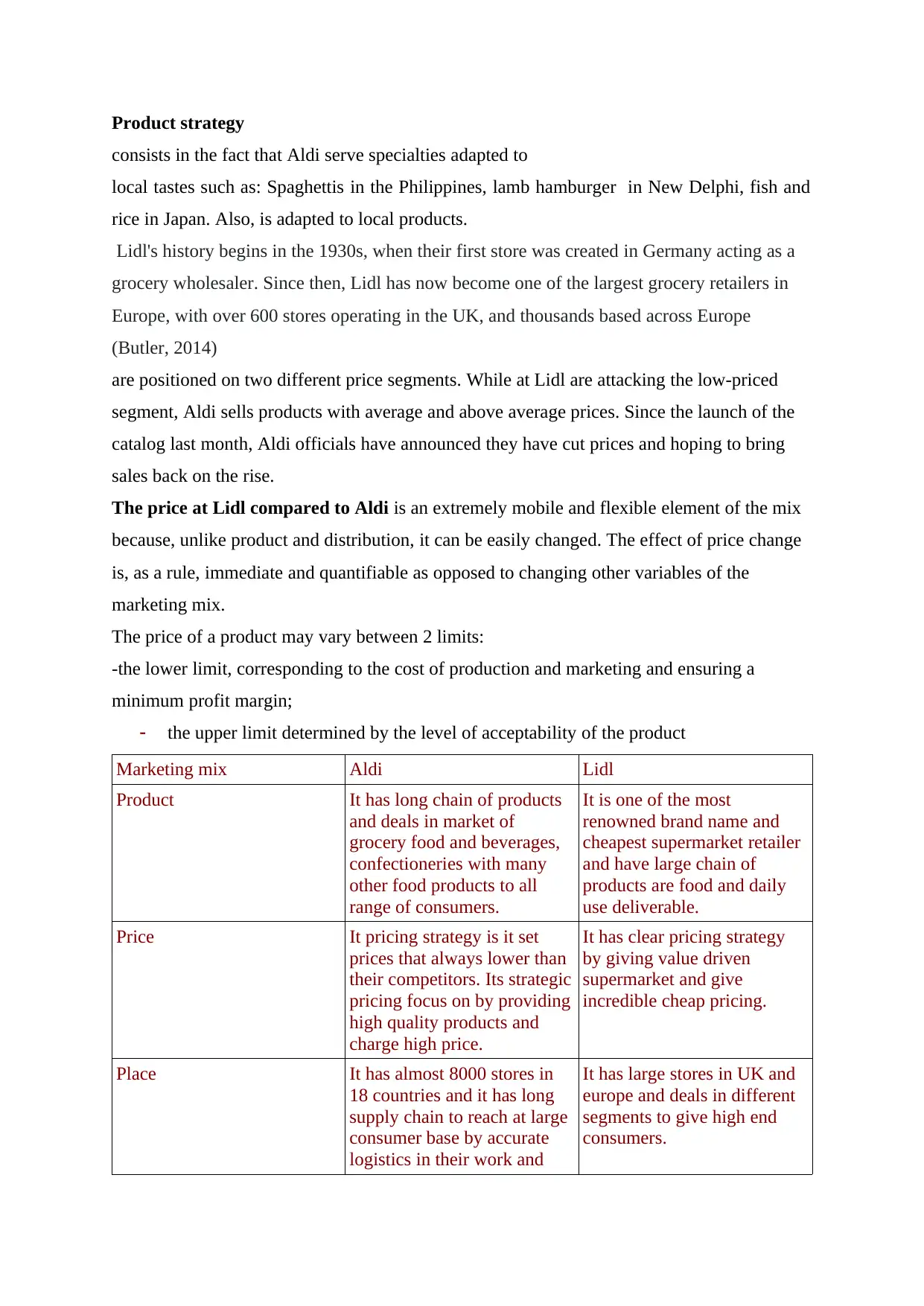
Product strategy
consists in the fact that Aldi serve specialties adapted to
local tastes such as: Spaghettis in the Philippines, lamb hamburger in New Delphi, fish and
rice in Japan. Also, is adapted to local products.
Lidl's history begins in the 1930s, when their first store was created in Germany acting as a
grocery wholesaler. Since then, Lidl has now become one of the largest grocery retailers in
Europe, with over 600 stores operating in the UK, and thousands based across Europe
(Butler, 2014)
are positioned on two different price segments. While at Lidl are attacking the low-priced
segment, Aldi sells products with average and above average prices. Since the launch of the
catalog last month, Aldi officials have announced they have cut prices and hoping to bring
sales back on the rise.
The price at Lidl compared to Aldi is an extremely mobile and flexible element of the mix
because, unlike product and distribution, it can be easily changed. The effect of price change
is, as a rule, immediate and quantifiable as opposed to changing other variables of the
marketing mix.
The price of a product may vary between 2 limits:
-the lower limit, corresponding to the cost of production and marketing and ensuring a
minimum profit margin;
the upper limit determined by the level of acceptability of the product
Marketing mix Aldi Lidl
Product It has long chain of products
and deals in market of
grocery food and beverages,
confectioneries with many
other food products to all
range of consumers.
It is one of the most
renowned brand name and
cheapest supermarket retailer
and have large chain of
products are food and daily
use deliverable.
Price It pricing strategy is it set
prices that always lower than
their competitors. Its strategic
pricing focus on by providing
high quality products and
charge high price.
It has clear pricing strategy
by giving value driven
supermarket and give
incredible cheap pricing.
Place It has almost 8000 stores in
18 countries and it has long
supply chain to reach at large
consumer base by accurate
logistics in their work and
It has large stores in UK and
europe and deals in different
segments to give high end
consumers.
consists in the fact that Aldi serve specialties adapted to
local tastes such as: Spaghettis in the Philippines, lamb hamburger in New Delphi, fish and
rice in Japan. Also, is adapted to local products.
Lidl's history begins in the 1930s, when their first store was created in Germany acting as a
grocery wholesaler. Since then, Lidl has now become one of the largest grocery retailers in
Europe, with over 600 stores operating in the UK, and thousands based across Europe
(Butler, 2014)
are positioned on two different price segments. While at Lidl are attacking the low-priced
segment, Aldi sells products with average and above average prices. Since the launch of the
catalog last month, Aldi officials have announced they have cut prices and hoping to bring
sales back on the rise.
The price at Lidl compared to Aldi is an extremely mobile and flexible element of the mix
because, unlike product and distribution, it can be easily changed. The effect of price change
is, as a rule, immediate and quantifiable as opposed to changing other variables of the
marketing mix.
The price of a product may vary between 2 limits:
-the lower limit, corresponding to the cost of production and marketing and ensuring a
minimum profit margin;
the upper limit determined by the level of acceptability of the product
Marketing mix Aldi Lidl
Product It has long chain of products
and deals in market of
grocery food and beverages,
confectioneries with many
other food products to all
range of consumers.
It is one of the most
renowned brand name and
cheapest supermarket retailer
and have large chain of
products are food and daily
use deliverable.
Price It pricing strategy is it set
prices that always lower than
their competitors. Its strategic
pricing focus on by providing
high quality products and
charge high price.
It has clear pricing strategy
by giving value driven
supermarket and give
incredible cheap pricing.
Place It has almost 8000 stores in
18 countries and it has long
supply chain to reach at large
consumer base by accurate
logistics in their work and
It has large stores in UK and
europe and deals in different
segments to give high end
consumers.
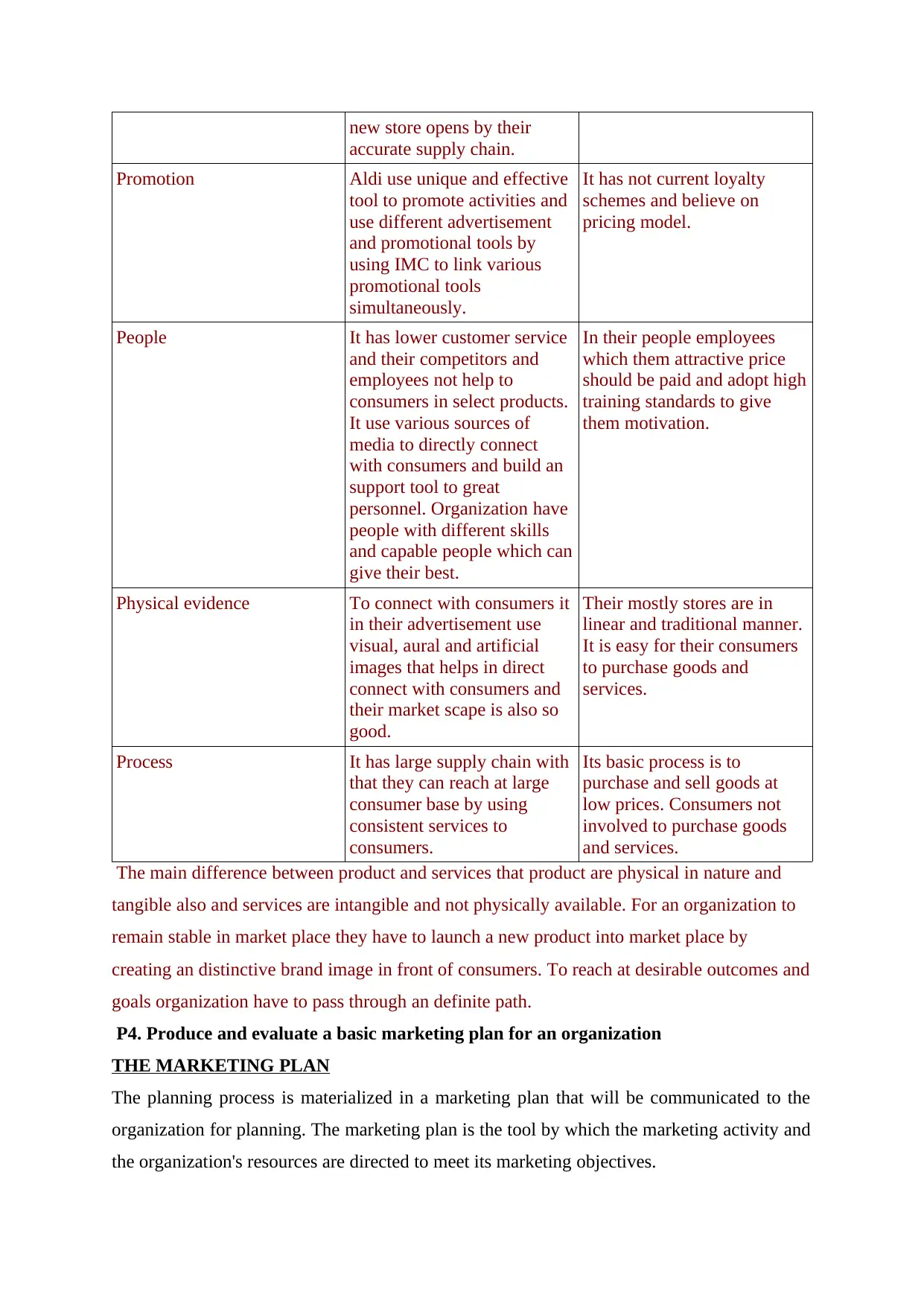
new store opens by their
accurate supply chain.
Promotion Aldi use unique and effective
tool to promote activities and
use different advertisement
and promotional tools by
using IMC to link various
promotional tools
simultaneously.
It has not current loyalty
schemes and believe on
pricing model.
People It has lower customer service
and their competitors and
employees not help to
consumers in select products.
It use various sources of
media to directly connect
with consumers and build an
support tool to great
personnel. Organization have
people with different skills
and capable people which can
give their best.
In their people employees
which them attractive price
should be paid and adopt high
training standards to give
them motivation.
Physical evidence To connect with consumers it
in their advertisement use
visual, aural and artificial
images that helps in direct
connect with consumers and
their market scape is also so
good.
Their mostly stores are in
linear and traditional manner.
It is easy for their consumers
to purchase goods and
services.
Process It has large supply chain with
that they can reach at large
consumer base by using
consistent services to
consumers.
Its basic process is to
purchase and sell goods at
low prices. Consumers not
involved to purchase goods
and services.
The main difference between product and services that product are physical in nature and
tangible also and services are intangible and not physically available. For an organization to
remain stable in market place they have to launch a new product into market place by
creating an distinctive brand image in front of consumers. To reach at desirable outcomes and
goals organization have to pass through an definite path.
P4. Produce and evaluate a basic marketing plan for an organization
THE MARKETING PLAN
The planning process is materialized in a marketing plan that will be communicated to the
organization for planning. The marketing plan is the tool by which the marketing activity and
the organization's resources are directed to meet its marketing objectives.
accurate supply chain.
Promotion Aldi use unique and effective
tool to promote activities and
use different advertisement
and promotional tools by
using IMC to link various
promotional tools
simultaneously.
It has not current loyalty
schemes and believe on
pricing model.
People It has lower customer service
and their competitors and
employees not help to
consumers in select products.
It use various sources of
media to directly connect
with consumers and build an
support tool to great
personnel. Organization have
people with different skills
and capable people which can
give their best.
In their people employees
which them attractive price
should be paid and adopt high
training standards to give
them motivation.
Physical evidence To connect with consumers it
in their advertisement use
visual, aural and artificial
images that helps in direct
connect with consumers and
their market scape is also so
good.
Their mostly stores are in
linear and traditional manner.
It is easy for their consumers
to purchase goods and
services.
Process It has large supply chain with
that they can reach at large
consumer base by using
consistent services to
consumers.
Its basic process is to
purchase and sell goods at
low prices. Consumers not
involved to purchase goods
and services.
The main difference between product and services that product are physical in nature and
tangible also and services are intangible and not physically available. For an organization to
remain stable in market place they have to launch a new product into market place by
creating an distinctive brand image in front of consumers. To reach at desirable outcomes and
goals organization have to pass through an definite path.
P4. Produce and evaluate a basic marketing plan for an organization
THE MARKETING PLAN
The planning process is materialized in a marketing plan that will be communicated to the
organization for planning. The marketing plan is the tool by which the marketing activity and
the organization's resources are directed to meet its marketing objectives.
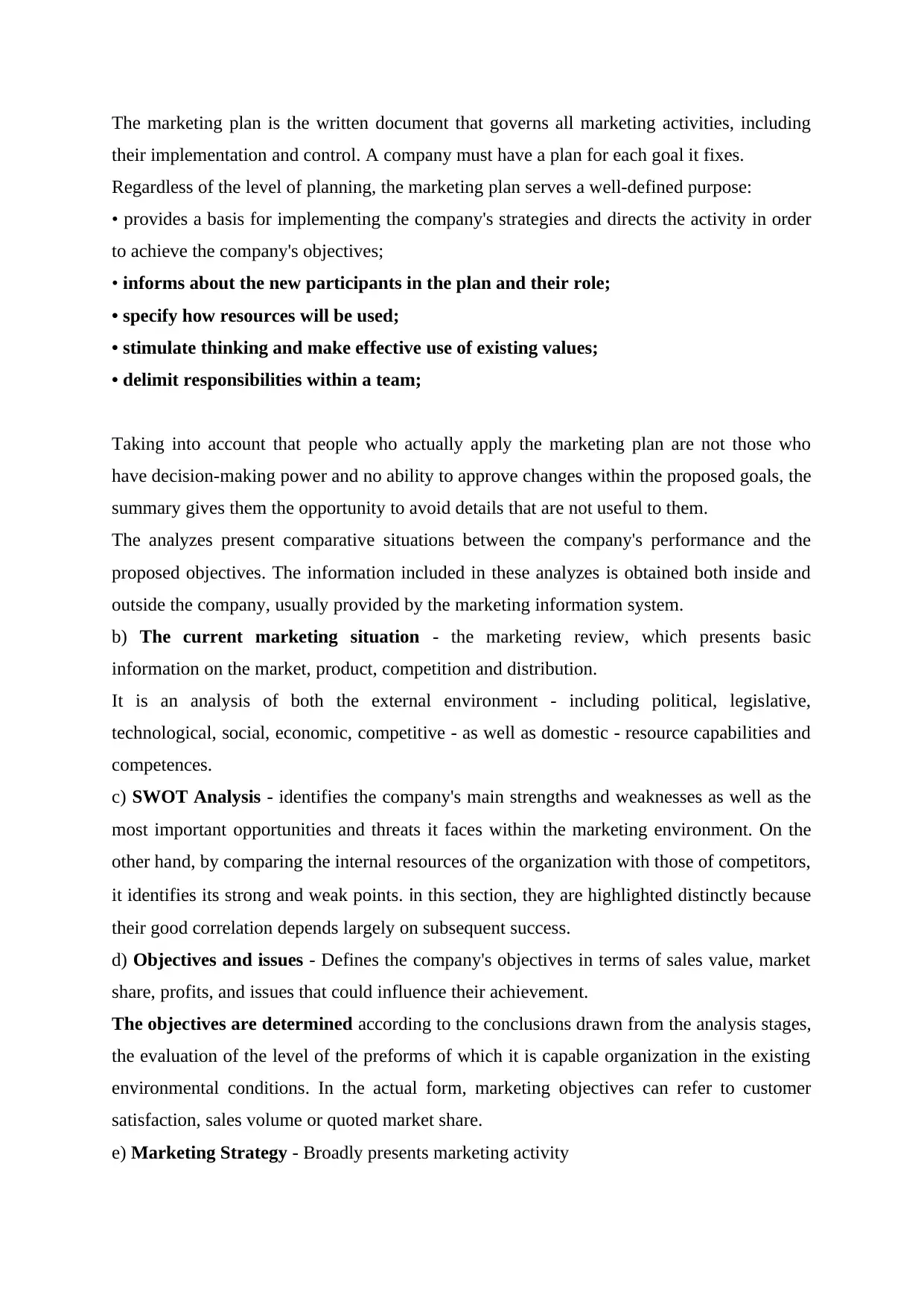
The marketing plan is the written document that governs all marketing activities, including
their implementation and control. A company must have a plan for each goal it fixes.
Regardless of the level of planning, the marketing plan serves a well-defined purpose:
• provides a basis for implementing the company's strategies and directs the activity in order
to achieve the company's objectives;
• informs about the new participants in the plan and their role;
• specify how resources will be used;
• stimulate thinking and make effective use of existing values;
• delimit responsibilities within a team;
Taking into account that people who actually apply the marketing plan are not those who
have decision-making power and no ability to approve changes within the proposed goals, the
summary gives them the opportunity to avoid details that are not useful to them.
The analyzes present comparative situations between the company's performance and the
proposed objectives. The information included in these analyzes is obtained both inside and
outside the company, usually provided by the marketing information system.
b) The current marketing situation - the marketing review, which presents basic
information on the market, product, competition and distribution.
It is an analysis of both the external environment - including political, legislative,
technological, social, economic, competitive - as well as domestic - resource capabilities and
competences.
c) SWOT Analysis - identifies the company's main strengths and weaknesses as well as the
most important opportunities and threats it faces within the marketing environment. On the
other hand, by comparing the internal resources of the organization with those of competitors,
it identifies its strong and weak points. in this section, they are highlighted distinctly because
their good correlation depends largely on subsequent success.
d) Objectives and issues - Defines the company's objectives in terms of sales value, market
share, profits, and issues that could influence their achievement.
The objectives are determined according to the conclusions drawn from the analysis stages,
the evaluation of the level of the preforms of which it is capable organization in the existing
environmental conditions. In the actual form, marketing objectives can refer to customer
satisfaction, sales volume or quoted market share.
e) Marketing Strategy - Broadly presents marketing activity
their implementation and control. A company must have a plan for each goal it fixes.
Regardless of the level of planning, the marketing plan serves a well-defined purpose:
• provides a basis for implementing the company's strategies and directs the activity in order
to achieve the company's objectives;
• informs about the new participants in the plan and their role;
• specify how resources will be used;
• stimulate thinking and make effective use of existing values;
• delimit responsibilities within a team;
Taking into account that people who actually apply the marketing plan are not those who
have decision-making power and no ability to approve changes within the proposed goals, the
summary gives them the opportunity to avoid details that are not useful to them.
The analyzes present comparative situations between the company's performance and the
proposed objectives. The information included in these analyzes is obtained both inside and
outside the company, usually provided by the marketing information system.
b) The current marketing situation - the marketing review, which presents basic
information on the market, product, competition and distribution.
It is an analysis of both the external environment - including political, legislative,
technological, social, economic, competitive - as well as domestic - resource capabilities and
competences.
c) SWOT Analysis - identifies the company's main strengths and weaknesses as well as the
most important opportunities and threats it faces within the marketing environment. On the
other hand, by comparing the internal resources of the organization with those of competitors,
it identifies its strong and weak points. in this section, they are highlighted distinctly because
their good correlation depends largely on subsequent success.
d) Objectives and issues - Defines the company's objectives in terms of sales value, market
share, profits, and issues that could influence their achievement.
The objectives are determined according to the conclusions drawn from the analysis stages,
the evaluation of the level of the preforms of which it is capable organization in the existing
environmental conditions. In the actual form, marketing objectives can refer to customer
satisfaction, sales volume or quoted market share.
e) Marketing Strategy - Broadly presents marketing activity
Secure Best Marks with AI Grader
Need help grading? Try our AI Grader for instant feedback on your assignments.
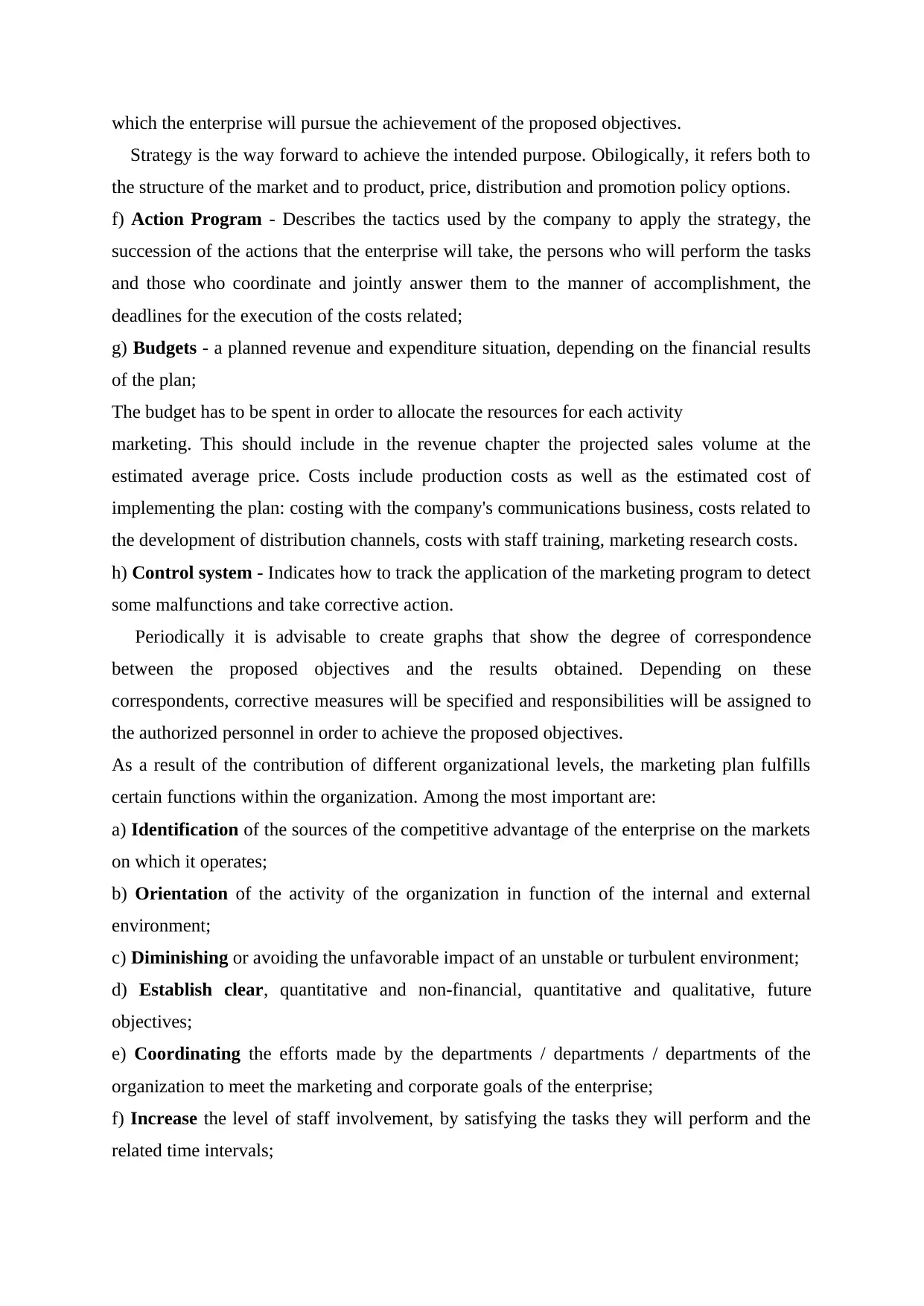
which the enterprise will pursue the achievement of the proposed objectives.
Strategy is the way forward to achieve the intended purpose. Obilogically, it refers both to
the structure of the market and to product, price, distribution and promotion policy options.
f) Action Program - Describes the tactics used by the company to apply the strategy, the
succession of the actions that the enterprise will take, the persons who will perform the tasks
and those who coordinate and jointly answer them to the manner of accomplishment, the
deadlines for the execution of the costs related;
g) Budgets - a planned revenue and expenditure situation, depending on the financial results
of the plan;
The budget has to be spent in order to allocate the resources for each activity
marketing. This should include in the revenue chapter the projected sales volume at the
estimated average price. Costs include production costs as well as the estimated cost of
implementing the plan: costing with the company's communications business, costs related to
the development of distribution channels, costs with staff training, marketing research costs.
h) Control system - Indicates how to track the application of the marketing program to detect
some malfunctions and take corrective action.
Periodically it is advisable to create graphs that show the degree of correspondence
between the proposed objectives and the results obtained. Depending on these
correspondents, corrective measures will be specified and responsibilities will be assigned to
the authorized personnel in order to achieve the proposed objectives.
As a result of the contribution of different organizational levels, the marketing plan fulfills
certain functions within the organization. Among the most important are:
a) Identification of the sources of the competitive advantage of the enterprise on the markets
on which it operates;
b) Orientation of the activity of the organization in function of the internal and external
environment;
c) Diminishing or avoiding the unfavorable impact of an unstable or turbulent environment;
d) Establish clear, quantitative and non-financial, quantitative and qualitative, future
objectives;
e) Coordinating the efforts made by the departments / departments / departments of the
organization to meet the marketing and corporate goals of the enterprise;
f) Increase the level of staff involvement, by satisfying the tasks they will perform and the
related time intervals;
Strategy is the way forward to achieve the intended purpose. Obilogically, it refers both to
the structure of the market and to product, price, distribution and promotion policy options.
f) Action Program - Describes the tactics used by the company to apply the strategy, the
succession of the actions that the enterprise will take, the persons who will perform the tasks
and those who coordinate and jointly answer them to the manner of accomplishment, the
deadlines for the execution of the costs related;
g) Budgets - a planned revenue and expenditure situation, depending on the financial results
of the plan;
The budget has to be spent in order to allocate the resources for each activity
marketing. This should include in the revenue chapter the projected sales volume at the
estimated average price. Costs include production costs as well as the estimated cost of
implementing the plan: costing with the company's communications business, costs related to
the development of distribution channels, costs with staff training, marketing research costs.
h) Control system - Indicates how to track the application of the marketing program to detect
some malfunctions and take corrective action.
Periodically it is advisable to create graphs that show the degree of correspondence
between the proposed objectives and the results obtained. Depending on these
correspondents, corrective measures will be specified and responsibilities will be assigned to
the authorized personnel in order to achieve the proposed objectives.
As a result of the contribution of different organizational levels, the marketing plan fulfills
certain functions within the organization. Among the most important are:
a) Identification of the sources of the competitive advantage of the enterprise on the markets
on which it operates;
b) Orientation of the activity of the organization in function of the internal and external
environment;
c) Diminishing or avoiding the unfavorable impact of an unstable or turbulent environment;
d) Establish clear, quantitative and non-financial, quantitative and qualitative, future
objectives;
e) Coordinating the efforts made by the departments / departments / departments of the
organization to meet the marketing and corporate goals of the enterprise;
f) Increase the level of staff involvement, by satisfying the tasks they will perform and the
related time intervals;

g) Allocation of resources for the various marketing activities, depending on their
contribution to the achievement of the established objectives;
h) Ensuring the unitary fulfillment by all managers and specialists of the enterprise of the
objectives, strategies and action programs;
Conclusion
The marketing plan is an important part of the business plan along with the plans for the
other functions of the enterprise: research and development, production, personnel and
financial . It will be developed for each division of the organization, strategic unit of activity,
product category and target market. In turn, business plans are an integral part of the
enterprise's strategic plan.
At McDonald’s Marketing strategy
Marketing strategy
the company considers the four components of the marketing mix: product, promotion,
distribution and price.
Product strategy
consists in the fact that Aldi's restaurants serve specialties adapted to
local tastes such as: Spaghettis in the Philippines, lamb hamburger (Maharaja ) in New
Delphi, fish and rice in Japan. Also, at Aldi is adapted to local products.
Commercial strategy
the hard-discount division, Aldi, and the hypermaket, Lidl, work completely separate. Aldi is
a hard-discount with a combined assortment of about 70% of private or exclusive brands. The
remaining 30% is made up of brands, but this percentage may vary by country.
"The relationship with Aldi can be a challenge for many functors, but it can also be an
opportunity, depending on the product offered. The Aldi mission is to create profit rather by
reducing operating costs than by boosting sales. That is why the commitment of a supplier for
the smallest operational costs is essential in the relationship with Aldi
Politics blazing brands
As for national brands, Aldi tends to focus on a limited range of leading brands. In the UK,
for example, brands marketed by Lidl are like Pepsi, Nestlé or Mars. Lately, many
discounters use brands to improve their image, and Aldi is no exception. Aldi supports
promoters' promotional programs and plans with them joint actions about nine months in
advance. Aldi also respects the local pricing policy for brands, but will want to get the lowest
market price for them.
contribution to the achievement of the established objectives;
h) Ensuring the unitary fulfillment by all managers and specialists of the enterprise of the
objectives, strategies and action programs;
Conclusion
The marketing plan is an important part of the business plan along with the plans for the
other functions of the enterprise: research and development, production, personnel and
financial . It will be developed for each division of the organization, strategic unit of activity,
product category and target market. In turn, business plans are an integral part of the
enterprise's strategic plan.
At McDonald’s Marketing strategy
Marketing strategy
the company considers the four components of the marketing mix: product, promotion,
distribution and price.
Product strategy
consists in the fact that Aldi's restaurants serve specialties adapted to
local tastes such as: Spaghettis in the Philippines, lamb hamburger (Maharaja ) in New
Delphi, fish and rice in Japan. Also, at Aldi is adapted to local products.
Commercial strategy
the hard-discount division, Aldi, and the hypermaket, Lidl, work completely separate. Aldi is
a hard-discount with a combined assortment of about 70% of private or exclusive brands. The
remaining 30% is made up of brands, but this percentage may vary by country.
"The relationship with Aldi can be a challenge for many functors, but it can also be an
opportunity, depending on the product offered. The Aldi mission is to create profit rather by
reducing operating costs than by boosting sales. That is why the commitment of a supplier for
the smallest operational costs is essential in the relationship with Aldi
Politics blazing brands
As for national brands, Aldi tends to focus on a limited range of leading brands. In the UK,
for example, brands marketed by Lidl are like Pepsi, Nestlé or Mars. Lately, many
discounters use brands to improve their image, and Aldi is no exception. Aldi supports
promoters' promotional programs and plans with them joint actions about nine months in
advance. Aldi also respects the local pricing policy for brands, but will want to get the lowest
market price for them.
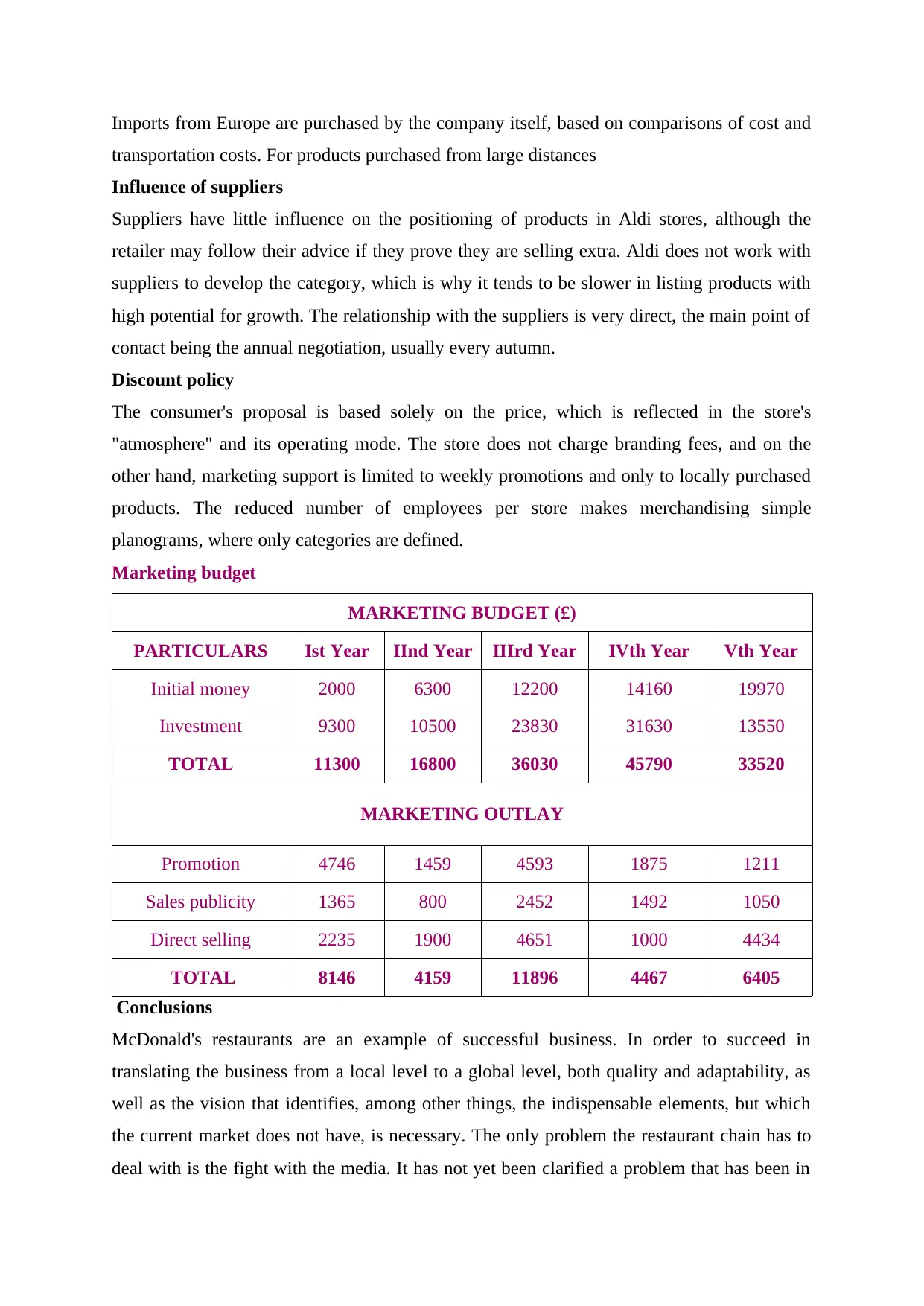
Imports from Europe are purchased by the company itself, based on comparisons of cost and
transportation costs. For products purchased from large distances
Influence of suppliers
Suppliers have little influence on the positioning of products in Aldi stores, although the
retailer may follow their advice if they prove they are selling extra. Aldi does not work with
suppliers to develop the category, which is why it tends to be slower in listing products with
high potential for growth. The relationship with the suppliers is very direct, the main point of
contact being the annual negotiation, usually every autumn.
Discount policy
The consumer's proposal is based solely on the price, which is reflected in the store's
"atmosphere" and its operating mode. The store does not charge branding fees, and on the
other hand, marketing support is limited to weekly promotions and only to locally purchased
products. The reduced number of employees per store makes merchandising simple
planograms, where only categories are defined.
Marketing budget
MARKETING BUDGET (£)
PARTICULARS Ist Year IInd Year IIIrd Year IVth Year Vth Year
Initial money 2000 6300 12200 14160 19970
Investment 9300 10500 23830 31630 13550
TOTAL 11300 16800 36030 45790 33520
MARKETING OUTLAY
Promotion 4746 1459 4593 1875 1211
Sales publicity 1365 800 2452 1492 1050
Direct selling 2235 1900 4651 1000 4434
TOTAL 8146 4159 11896 4467 6405
Conclusions
McDonald's restaurants are an example of successful business. In order to succeed in
translating the business from a local level to a global level, both quality and adaptability, as
well as the vision that identifies, among other things, the indispensable elements, but which
the current market does not have, is necessary. The only problem the restaurant chain has to
deal with is the fight with the media. It has not yet been clarified a problem that has been in
transportation costs. For products purchased from large distances
Influence of suppliers
Suppliers have little influence on the positioning of products in Aldi stores, although the
retailer may follow their advice if they prove they are selling extra. Aldi does not work with
suppliers to develop the category, which is why it tends to be slower in listing products with
high potential for growth. The relationship with the suppliers is very direct, the main point of
contact being the annual negotiation, usually every autumn.
Discount policy
The consumer's proposal is based solely on the price, which is reflected in the store's
"atmosphere" and its operating mode. The store does not charge branding fees, and on the
other hand, marketing support is limited to weekly promotions and only to locally purchased
products. The reduced number of employees per store makes merchandising simple
planograms, where only categories are defined.
Marketing budget
MARKETING BUDGET (£)
PARTICULARS Ist Year IInd Year IIIrd Year IVth Year Vth Year
Initial money 2000 6300 12200 14160 19970
Investment 9300 10500 23830 31630 13550
TOTAL 11300 16800 36030 45790 33520
MARKETING OUTLAY
Promotion 4746 1459 4593 1875 1211
Sales publicity 1365 800 2452 1492 1050
Direct selling 2235 1900 4651 1000 4434
TOTAL 8146 4159 11896 4467 6405
Conclusions
McDonald's restaurants are an example of successful business. In order to succeed in
translating the business from a local level to a global level, both quality and adaptability, as
well as the vision that identifies, among other things, the indispensable elements, but which
the current market does not have, is necessary. The only problem the restaurant chain has to
deal with is the fight with the media. It has not yet been clarified a problem that has been in
Paraphrase This Document
Need a fresh take? Get an instant paraphrase of this document with our AI Paraphraser
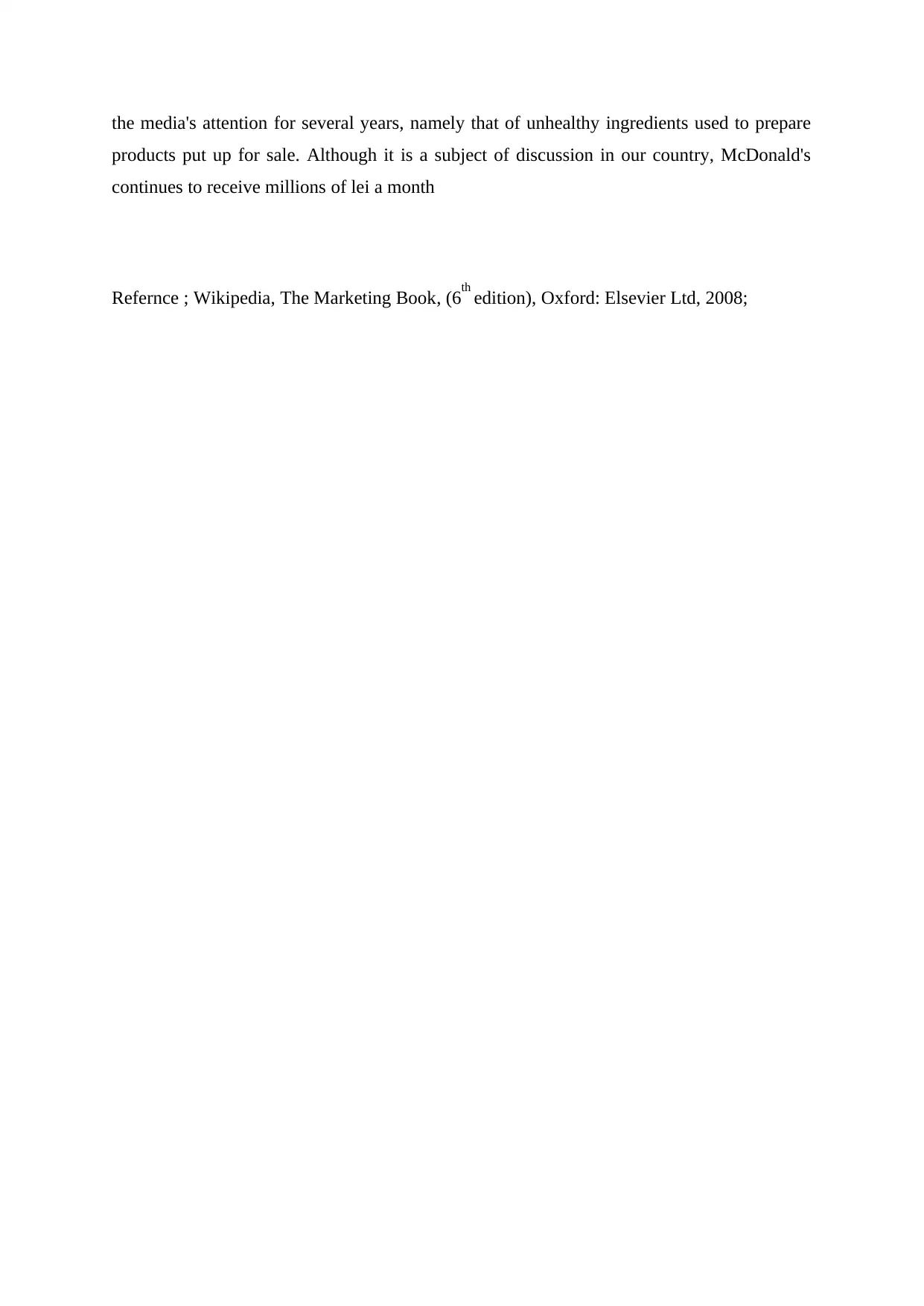
the media's attention for several years, namely that of unhealthy ingredients used to prepare
products put up for sale. Although it is a subject of discussion in our country, McDonald's
continues to receive millions of lei a month
Refernce ; Wikipedia, The Marketing Book, (6th edition), Oxford: Elsevier Ltd, 2008;
products put up for sale. Although it is a subject of discussion in our country, McDonald's
continues to receive millions of lei a month
Refernce ; Wikipedia, The Marketing Book, (6th edition), Oxford: Elsevier Ltd, 2008;
1 out of 14
Related Documents
Your All-in-One AI-Powered Toolkit for Academic Success.
+13062052269
info@desklib.com
Available 24*7 on WhatsApp / Email
![[object Object]](/_next/static/media/star-bottom.7253800d.svg)
Unlock your academic potential
© 2024 | Zucol Services PVT LTD | All rights reserved.





